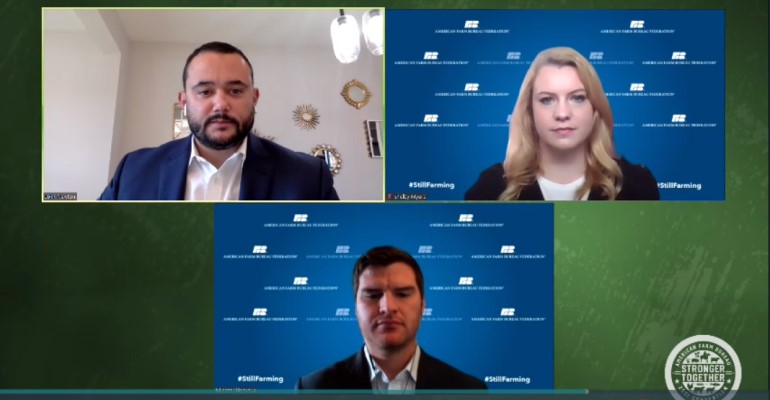Farm Bureau economists weigh in on what the likely biggest ag market movers will be in 2021.

China’s demand for protein, and feedstuffs to feed their domestic herd, remains the “big elephant in the room” when looking at how U.S. agricultural producers could build on what ended up being a strong 2020 finish. During an economic outlook session held during the American Farm Bureau Federation’s virtual convention Jan. 12, three in-house economists offered positive indicators of more good news ahead.
Michael Nepveux, AFBF livestock economist, says that the trade war overshadowed the downward spiral African Swine Fever had on China’s domestic production since decimating the country’s hog herd starting in 2018, but China is still “very much a driver in livestock and protein markets.” China accounts for half of the world’s consumption and production of pork. When 25-30% of China’s production disappeared, it left a huge hole in pork markets that shifted around global trade flows, Nepveux says.
This brought about large increases in pork, beef and poultry exports to China. Prior to 2020, poultry imports were limited but the technical changes included in the phase one agreement allowed for resumption of poultry trade.
Nepveux says China is looking at a 10-20% increase in domestic pork production but is still facing a deficit in its pork supply. U.S. pork exports are up 7% to China and beef up 13%.
Foreign Agricultural Service shipment data shows both beef and pork exports should finish the 2020 year strong. Nepveux says there’s a lot of momentum heading into 2021 as China rebuilds its swine herd. If China doesn’t get it from the U.S., they’re still importing as much beef, pork and chicken as they can, he explains.
AFBF Economist Shelby Myers adds, “Despite tariffs, China is returning as a demand partner for U.S. commodities.”
Myers notes that China also has imported more U.S. corn than ever before, going from the 15th largest destination for U.S. corn to fourth. And China is also expected to import record amounts of soybeans as it looks to rebuild its herd. “They want livestock feed,” Myers adds, noting that world imports also point to higher levels for sorghum, barley and wheat.
Brazil’s drought and Argentina’s suspension of corn exports until March 1 also make the U.S. an “attractive export partner,” Myers says.
Lead AFBF Economist John Newton says China is not expected to meet its phase one year one target of $33-$36 billion, but currently sits at $22.5 billion with 11 months of data. He says China will likely fall short on those targets depending on how strong exports finish in December, but still at record levels of trade.
The million-dollar question is how President-elect Joe Biden views China and whether he will continue or not continue the phase one agreement and if there will be a phase two. He says AFBF will work with the new U.S. Trade Representative to communicate the benefits of the first installment.
Trade outlook
Newton adds trade in general will be an important indicator in the economic outlook for 2021. Trump renegotiated trade agreements representing 50% of U.S. markets. “Where do we go from here,” Newton asks. “Do we focus on bilateral?”
As vaccines become more available, he says after the COVID situation is handled domestically the incoming administration can look at expanding market access around the world. Biden says his first agenda items look inward domestically. “Once we get past COVID-19 and we’ve vaccinated our population, we can turn our eye to global markets,” he says.
The Obama Administration forged the Trans Pacific Partnership, although President Trump withdrew from the agreement. Newton says Biden re-entering or re-engaging with TPP partners could be “something worthy of consideration.”
Nepveux says TPP offered a huge win for the livestock sector. “I wouldn’t be surprised if we do end up re-engaging” on TPP, especially considering the geopolitics of countering China’s strength in the region. “I think from a livestock perspective it would be a smart move.”
Myers adds that TPP also offered a lot of opportunities for crop markets of the now Comprehensive and Progressive Agreement for Trans-Pacific Partnership member countries and could offer a “huge opportunity for U.S. producers going forward.”
Drought implications
The drought was present in 2020, but the spread didn’t get as much attention. Nepveux says roughly 50% of the country is in D1 to D4 conditions, and if “abnormally dry conditions” are added the dry conditions cover two-thirds of the United States. Parts of Texas, Oklahoma and many parts of the West are in pretty bad condition, he explains.
“I don’t think it impacted herd liquidation, but it could be a much bigger deal in 2021,” Nepveux says. Deteriorating pasture and forage as well as rising feed costs could complicate the outlook scenario for livestock producers.
About the Author(s)
You May Also Like





